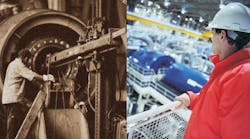When I joined Machine Design three years ago, my No.1 goal was to expand my knowledge of engineering best practices and its relationship to the manufacturing industry. To be successful, I would need to lean on my teammates for guidance and embed myself in the industry by latching onto real-world engineering examples worthy of sharing with our audiences.
Today, with a healthy dose of humility, I proudly accepted the invitation to write the editor’s note for Machine Design’s first issue of 2023. Those in my immediate sphere of influence know my commitment and hold the bulk of my gratitude.
I’d be stretching the truth if I said the path to this moment was a fluke. The seeds for my deep interest in engineering was planted many years ago. As an MBA student, I was required to take an entire course devoted to The Theory of Inventive Problem Solving, or TRIZ. As a systematic approach, it provides a suite of tools for recognizing contradictions as they arise and solving them without compromise.
Students were asked to use TRIZ to solve engineering problems, such as designing a fan without blades (Dyson did that!) or redesigning a muffler to reduce noise. I learned that building off other ideas is a tried-and-true method of problem solving—and it inspires creativity. Adherents to TRIZ problem-solving algorithms can be found at many organizations, from Airbus, Saint-Gobain, Doosan Babcock, Kraft and QinetiQ to Trelleborg, Rolls Royce and BAE Systems.
From the innovator’s perspective, the notion of gaining access to others’ ideas and connecting the right things to solve new problems has a storied history. Roll back the concept to the 17th Century to connect with Sir Isaac Newton’s familiar line on scientific progress: “If I have seen further it is by standing on the shoulders of giants.” The famed expression, written in a letter in 1675 intended for physicist Robert Hooke (who devised Hooke’s law and built a new type of Gregorian telescope), was penned at a time when Newton engaged Hooke in intense correspondence about gravitation. (Their relationship reportedly soured later on.)
Contemporary concepts such as the metaverse and digital twins arguably can be equated to Newton’s 17th Century imagined ideas of mass, gravity and velocity, which we now take for granted. The concept of digital twins is an example of an invention that is building on itself, with each digital simulation rendering a smarter version of a product or system that is greater than the sum of its parts.
Building on past innovations to develop current technologies turned out to be a common thread among the articles curated for our January/February issue. A spotlight on the space economy launches Machine Design’s exploration of questions and use cases on how aerospace, medical tech, semiconductor and other manufacturers are pursuing first-mover advantage in the private-sector space environment. SpaceRyde is a Canadian startup that has designed a three-stage small satellite launcher targeted for Earth and lunar orbit missions. The rocket system uses a stratospheric balloon (not a new invention) to bypass 99% of the atmosphere before the rocket launches from a proprietary rocket carrier. The manufacturer plans to build a network of smart rockets that can provide cost-effective ways to transport cargo to and from low-Earth orbit.
At the moment, the space economy generates most value by enabling activities on Earth. But thanks to greater access, lower costs and sophisticated technological innovations—notably in computer-aided design and 3D printing, artificial intelligence and autonomous robotics—business and engineering services in orbit may be at the tipping point.
One notable effect of latching onto the many ways science and technologies are reshaping engineering is that it also amplifies our awareness of the societal effects. Our recent insights into an American Society of Mechanical Engineers (ASME) report on the general shift towards design for manufacturing indicate how new workflows, roles and skills will foster Industry 4.0 business outcomes.
This year, count on Machine Design to track both proven and novel design engineering methods along the arc of technical and socio-economic change. There is a lot to explore, and I hope this issue inspires and provokes.
Your feedback ensures our relevance. Reach me at [email protected].

